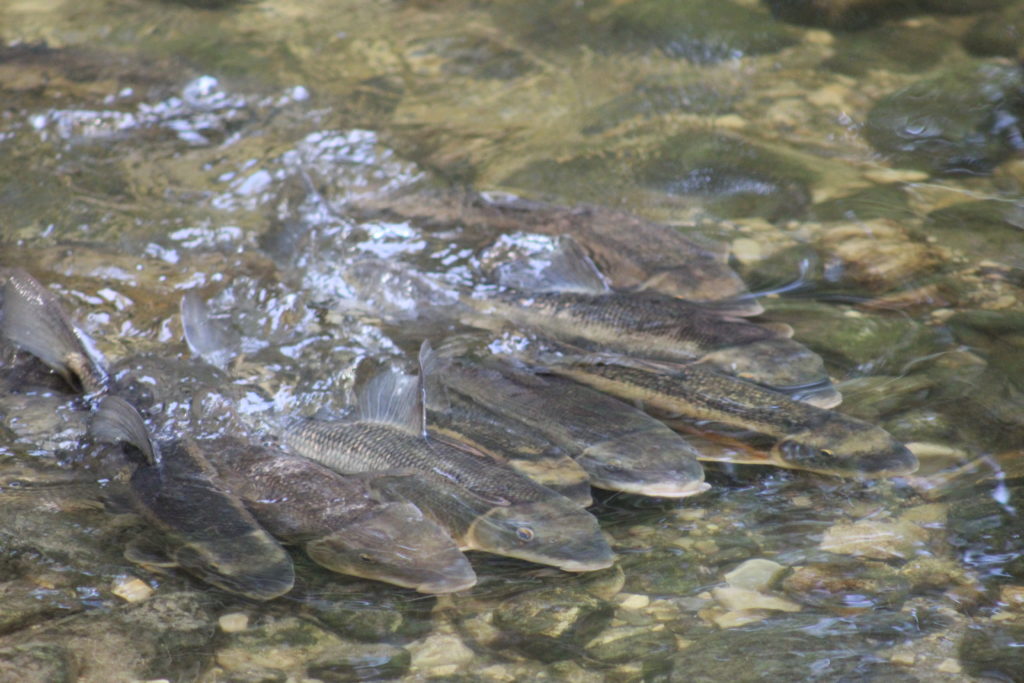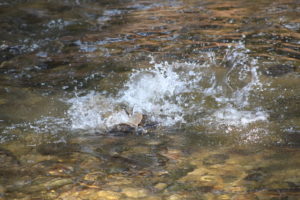
White suckers migrate up Silver Creek in Manitowoc to spawn. Image credit: Titus Seilheimer
By Titus Seilheimer, Wisconsin Sea Grant Fisheries Outreach Specialist
Spring is the right time to head to your local stream to see the migration and spawning of Great Lakes sucker species. As water temperatures warm, white and longnose suckers feel the need to move from the Great Lakes into tributaries. They congregate in large groups and create the next generation of fish.
Sucker migrations are ecologically important, especially to smaller headwater streams, which benefit from the nutrients and energy inside the suckers as they move from the Great Lakes deep into watersheds. Suckers get a bad rap from anglers and the public because of the misconceptions that they eat sportfish eggs and compete with desirable species. However, small suckers are important food sources for many predator species and have a vital ecological role in our food webs.
Smaller streams can be great locations to spot these fish, because they mostly ignore people when spawning is on their minds. Suckers will start spawning in early April when the water reaches 7 degrees C (45 degrees F) and will return to the lake when finished. Temperature is an important cue along with water flow.
Yesterday in Manitowoc, I spotted about 100 white suckers in Silver Creek. Some were actively spawning and others were hanging out in a deep pool (probably waiting to move upstream). Areas with gravel and good flowing water are spawning habitat for suckers. This is what the scene might look like https://youtu.be/AgAvlCeuwJM
Sucker-watching tips

If they are splashing, they are spawning! White suckers in Silver Creek in Manitowoc. Image credit: Titus Seilheimer
Find a fairly shallow or narrow stream or river to watch. Water clarity is important because it’s hard to see fish in a cloudy or turbid river. Cut down the glare with polarized sunglasses. For observing spawning suckers, find a rocky area with moving water. Sit on the bank and watch. Early and late in the day are good times to look for active spawning. Keep an eye open for other species too, like small fishes or crayfish. White suckers are common throughout Wisconsin, so many streams will have spawning happening even away from the Great Lakes.
If community science to track suckers is interesting, check out the Shedd Aquarium’s sucker monitoring program in Lake Michigan. Karen Murchie is working with volunteers up the Lake Michigan coast to record daily numbers of suckers at specific sites and learn more about why and when suckers migrate. Follow these hashtags on social media #suckerforsuckers #drabisthenewfab #suckerwatch2021. https://www.sheddaquarium.org/care-and-conservation/shedd-research/investigating-great-lakes-sucker-migrations
https://news.wttw.com/2021/03/22/great-lakes-wildebeests-move-spring-migration-starts
If you’re close to northeastern Wisconsin (and it is safe to travel), watching the spawning sturgeon in the Wolf River is another must-do trip. Mid-April to early May is the typical time to see these ancient giants up close! https://dnr.wisconsin.gov/topic/Fishing/sturgeon/SturgeonSpawning.html
And here’s a Sea Grant video of sturgeon spawning:


